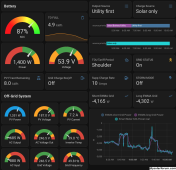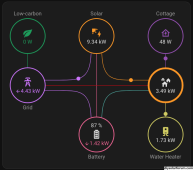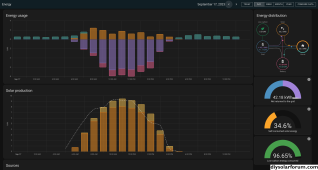scoharri
New Member
I bought one but haven't got it running yet
And in the process grossly violate the GPL, which is why I will never buy it. I have very small server cluster at home and there is no need for another Rasberry Pi to litter my home when I can easily spin up a virtual machine.The guys from sa created the drivers for inverters and batteries and packaged a collection of open source software packages together to make a complete solution
??Use it, love it, and it doesn’t void my warranty lolz
I don't use it for anything but monitoring my system.I like the idea of home automation, but who wants to be changing settings all the time if ever....I like set it and forget it for anything major and hardwired manual switches for the redundant equipment. Isn't there equipment and software already setup and marketed for home automation? I can see the draw to Solar Assistant only if there is some financial incentive to use SA over others.
Simply put it’s a nice app and interface to any solar system.I like the idea of home automation, but who wants to be changing settings all the time if ever....I like set it and forget it for anything major and hardwired manual switches for the redundant equipment. Isn't there equipment and software already setup and marketed for home automation? I can see the draw to Solar Assistant only if there is some financial incentive to use SA over others.
With SA and HA, it’s set it and forget it for changing settings. Can even alert your phone when conditions change if you want. No manual intervention. SA itself is great for metrics. The data can be greatly enhanced, merged with other data, and displayed however you like with HA/Grafana.I like the idea of home automation, but who wants to be changing settings all the time if ever....I like set it and forget it for anything major and hardwired manual switches for the redundant equipment. Isn't there equipment and software already setup and marketed for home automation? I can see the draw to Solar Assistant only if there is some financial incentive to use SA over others.
100% the same here.I don't use it for anything but monitoring my system.
But I like the ability to change something, if needed. From anywhere in the world.
I use the power supply Solar Assistant sells. https://solar-assistant.io/shop/products/dc_usb_psu_type_cUse it, and love it. Combined with Home Assistant, it turns on my hot water heater when there's PV power in excess of the heating element wattage so I can consume it instead of getting less ? from net-metering.
If you're connecting it to an inverter via RS232/RS485/etc. I recommend getting an isolated converter for extra protection to make sure that both the inverter and Solar Assistant box aren't damaged by voltage surges on the other device; I have one of the ones these guys make:
https://www.commfront.com/collections/rs232-rs485-rs422-ttl-serial-opto-isolators (no affiliation)
For complicated reasons I can't use the DC power supply, so I'm using the AC-to-USB-C power supply; definitely less of an issue if you're using the DC one, for sure ?I use the power supply Solar Assistant sells. https://solar-assistant.io/shop/products/dc_usb_psu_type_c
That's the whole point of automation.I like the idea of home automation, but who wants to be changing settings all the time if ever....I like set it and forget
They would need your log in details.Basically you have to register the app and there is an option for remote view ,is it safe ? , can someone go to the main hosting and from there change your setting remotely ?
Using RS232 on Sol-Ark and looking at that link I see a 3 and 7 wire isolation device. Not sure which one to use or what’s the difference for my setup?If you're connecting it to an inverter via RS232/RS485/etc. I recommend getting an isolated converter for extra protection to make sure that both the inverter and Solar Assistant box aren't damaged by voltage surges on the other device; I have one of the ones these guys make:
https://www.commfront.com/collections/rs232-rs485-rs422-ttl-serial-opto-isolators (no affiliation)



Solar Assistant combines the data from my EASun 8kW inverter and Victron Smart Shunt. Integrated via MQTT with Home Assistant (and Node Red).
Automations manage the Output Source priority, the Charge Source Priority and the Maximal Grid Charge Current settings. There is also a Storm Mode which can be activated by choice or set up to trigger automatically if needed.
Without SA I doubt these would be so easily achieved.
I don't however look at the SA dashboard much. Most of my data is viewed via Home Assistant, and also data captured with InfluxDB and use Grafana for granular view/analysis.
I grabbed the 7-wire one because I figured "more is better"; the only difference is that the 3-wire one isolates only the transmit/receive and ground pins, vs. the 7-wire one that isolates those and a few more of them. $35 vs $60 isn't much of a difference vs. the cost of a multi-thousand-dollar inverter, in my mind.Using RS232 on Sol-Ark and looking at that link I see a 3 and 7 wire isolation device. Not sure which one to use or what’s the difference for my setup?
Probably not...need integrations from various manufactures products and not all are supported.So, it seems like a hub integration for HA that brings a whole group of <edit>devices</edit> to HA with one integration?
Seems like most of that is available as stand alone integrations for Home Assistant, no?


